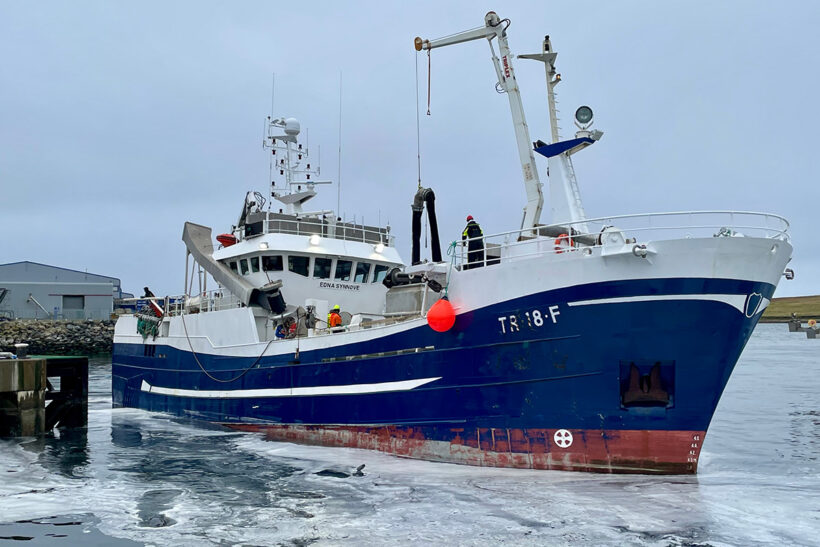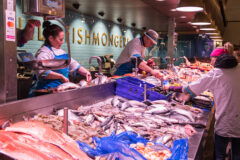Scientists from four countries, sailing on five research vessels, have reported a 42% drop in mackerel biomass, and near halving of mackerel abundance, that could have far-reaching impacts on the TAC advice from ICES that will be published later this year.
The results were reported at a meeting between coastal states last week to discuss management and quota shares of the three main pelagic stocks. Management of all three has been controversial, with the Nordic states issuing themselves increases in their relative shares of the TAC, with the result that the total quota issued is over 140% of the ceiling recommended by ICES.
The ongoing dispute has led to loss of MSC accreditation of the stocks, warnings by NGOs and others that the stocks face rapid decline due to overfishing, and the threat of a boycott of products from the three stocks by a large group of international processors and wholesalers, working together under the banner of the North Atlantic Pelagic Advocacy Group (NAPA).
The UK, which for many years opposed the unilateral moves by Nordic states, effectively switched sides in the dispute 12 months ago, agreeing a ‘quota for access’ deal with Norway. In June this year, that was expanded to also include Faroe, and was extended for the three years 2024 to 2027, effectively binding the hands of the incoming UK fisheries minister.
The EU Commission has responded to the ongoing impasse by recommending that EU ministers and the EU parliament strengthen potential sanctions against coastal states that fish for shared stocks ‘unsustainably’.

Relative abundance of Atlanto-Scandian herring (red), mackerel (yellow) and blue whiting (blue) seen during the five-week survey.
The 42% reduction in mackerel biomass – and a 24% reduction in herring – may not translate directly into the ICES advice for 2025, but will undoubtedly point it in this direction.
Aodh O Donnell, CEO of the Irish Fish Producers’ Organisation, told FN: “The coastal states sharing of mackerel is in a state of chaos. The sustainability of mackerel as a key migratory stock with wide distribution is threatened by consistent and persistent overfishing by Norway. There is no commitment to sustainable fisheries management by Norway and other Nordic coastal states. Their fishing exceeds the sum of the agreed TAC by as much as 45%.
“As the main EU quota holder for western mackerel, Ireland adheres to robust science and sustainable practices. In the last few years, this has meant significant quota reductions impacting Ireland.
“We are not surprised by concerns around biomass given this gross overfishing by Nordic states. The fallacy of zonal attachment as a basis for self-awarded inflated quotas is also being exposed. Norwegian vessels now rely on access to UK waters to catch these enormous catches. Norway hauled in over 53,000t of mackerel last week. An estimated 90% was taken in UK waters, mainly to the southeast of Shetland.
“We cannot reward irresponsible behaviours in the North East Atlantic. Europe must act and apply appropriate and meaningful trade measures. The UK too must act alongside Europe to stop these reckless practices, before it is too late.”
Speaking for NAPA, Rob Blyth-Skyrm said: “On behalf of NAPA members I attended the recent coastal states plenary session on mackerel, and listened with concern that summer survey data indicates a further decline in the mackerel stock.
“We await publication of the completed stock assessments and full ICES advice on mackerel and herring with great interest. The NAPA species subgroups will then reconvene to discuss findings and what further action needs to be taken.”
Findings from five-week international survey
Five vessels, from Iceland, Faroe, Norway and Denmark, covered 14,249nm of survey transects during the co-ordinated five- week annual survey, which first started in 2010.
Multibeam echosounders and sonar were used to identify the species of fish located and estimate abundance. This was then ‘ground-truthed’ with several hundred tows of pelagic gear where fish were found. Samples of the fish caught were aged and measured, with results standardised between vessels, and compared with previous years’ data, to gain as full an understanding of the state of the stocks as possible.
The results for mackerel suggested a biomass for the stock of around 2.5m tonnes, covering a sea area of 2.4m square kilometres, with fish averaging 460g each.
For herring, already subject to a TAC reduction in 2024, the survey found a further 24% reduction in the overall biomass index in 2024, to 3.78m tonnes, nearly all of which was found in the eastern half of the survey area.
For blue whiting, subject to a major TAC increase in 2024, when many in the Scottish industry had argued for a smaller increase, spread over 2024 and 2025, the biomass index remained almost unchanged, at just below 2m tonnes.
The survey is undertaken at the same transects every year, with scientists making great efforts to standardise as much as possible in analysing the results, to allow accurate year on year comparisons, and to ensure results from different vessels are 100% comparable.
The ‘snapshot’ of where fish were found during their extensive annual migrations will be assessed very carefully by different coastal states, each wanting to put their own spin on the distribution of stocks to justify greater quota shares. For the 2024 survey, mackerel were not seen anywhere in eastern Icelandic waters, where they have occasionally been seen in previous years. Blue whiting, which tend to prefer warmer waters, were found in the southern half of the survey area, but were also seen in the southeastern section of the Icelandic EEZ in significant numbers.
The surveys, and the biomass estimates produced from the work, are not in themselves a full stock assessment, but provide hugely valuable sets of data that will feed into the actual assessment, along with catch and effort data from commercial fishing, sampling data from commercial vessels and in some cases surveys of egg abundance that can also provide further information about the size of spawning stocks.
It is highly likely, though, that trends picked up by the survey will correlate closely with ICES advice for the 2025 TACs, coming after several years of cumulative overfishing on all three pelagic stocks, as coastal states argue about relative quota shares.
The survey also picked up small numbers of salmon, most of them smolts or smaller grilse, but scientists didn’t say whether the relative abundance or distribution of the salmon had changed relative to previous years.
The full ICES advice is expected later this autumn.
This story was taken from the latest issue of Fishing News. For more up-to-date and in-depth reports on the UK and Irish commercial fishing sector, subscribe to Fishing News here or buy the latest single issue for just £3.50 here.
Sign up to Fishing News’ FREE e-newsletter here.
Main image credit: Sydney Sinclair






